Gooday all,
Yesterday I was able to get out and fly my Mavic air 2 in a local park for the first time in a couple of weeks[due severe winter storms with wind gusts up to 100klm's per hour]
I had launched the drone with everything in and locked, weather was sunny with very little wind.
I had been flying within the surrounds of the park at about a height of 30 metres for about 10 minutes when I noticed a darkish cloud forming around the drone. I then realised my drone was being attacked by a large swarm of aggressive bees. I immediately ascended to about 50-60 metres but the swarm still persisted converging on the drone, so I descended down to about 10 metres to a point where the bees started to lose interest. I decided it better to call it a day right then and there and successfully landed my drone on the pad. After engine shutdown, I picked up my air 2 and could not believe the state that it was in. Every part of the drone front and rear was covered in bee detritus,heads wings tails and a sticky residue.What most concerns me is that a lot of the sensors have this stuff stuck in the surrounding crevices.
My question is, how do I clean up the drone and dispense with all this sticky litter etc without getting fluid/water ingress into the electrical compartments and fluid sensitive areas.
I have had to discard the props,as all the leading edges will have been damaged by the bee parts slamming into them.
Any help or advice will be appreciated. As you can imagine I am pretty distraught at the condition of my drone and I honestly don't know where to start the cleanup.
Thanks Phil.
Yesterday I was able to get out and fly my Mavic air 2 in a local park for the first time in a couple of weeks[due severe winter storms with wind gusts up to 100klm's per hour]
I had launched the drone with everything in and locked, weather was sunny with very little wind.
I had been flying within the surrounds of the park at about a height of 30 metres for about 10 minutes when I noticed a darkish cloud forming around the drone. I then realised my drone was being attacked by a large swarm of aggressive bees. I immediately ascended to about 50-60 metres but the swarm still persisted converging on the drone, so I descended down to about 10 metres to a point where the bees started to lose interest. I decided it better to call it a day right then and there and successfully landed my drone on the pad. After engine shutdown, I picked up my air 2 and could not believe the state that it was in. Every part of the drone front and rear was covered in bee detritus,heads wings tails and a sticky residue.What most concerns me is that a lot of the sensors have this stuff stuck in the surrounding crevices.
My question is, how do I clean up the drone and dispense with all this sticky litter etc without getting fluid/water ingress into the electrical compartments and fluid sensitive areas.
I have had to discard the props,as all the leading edges will have been damaged by the bee parts slamming into them.
Any help or advice will be appreciated. As you can imagine I am pretty distraught at the condition of my drone and I honestly don't know where to start the cleanup.
Thanks Phil.











